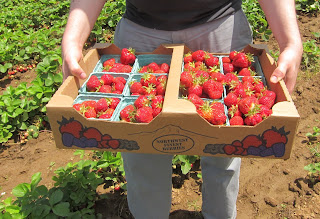 Way back when, I visited an old friend in Boston only to discover she had turned a sickly shade of yellow. "Holy cow," I said. "Do you have jaundice?"
Way back when, I visited an old friend in Boston only to discover she had turned a sickly shade of yellow. "Holy cow," I said. "Do you have jaundice?""No," she replied. "I just eat a lot of carrots."
Erica had discovered Boston's Haymarket: not a riot, more than just a T stop, Haymarket is a nearly 200-year-old tradition in the heart of Boston's downtown. I think I lived in Boston (meaning Cambridge) for eight years without ever going to the Haymarket. This was probably because, back then, the Haymarket lived in the shadow of Boston's central artery, the elevated freeway that used to divide downtown Boston from its harbor. Everything around the central artery was super-sketch and generally unpleasant.
No more. Whatever else one might think of Boston's infamous Big Dig, it did succeed in opening up this core slice of central Boston. In place of the looming concrete jungle of pollution and noise, we now have a human-scaled park and a sense of openness in the midst of the city. This makes the Haymarket rather more appealing as a Saturday morning field trip.
 |
| The Rose Kennedy Parkway: Much more pleasant than a freeway. |
I love an outdoor produce market. With surly vendors, mounds of bright vegetables, and a cross-section of Boston's diverse population, Haymarket reminds me of a scaled-down version of the Hague's Turkish Market. The Haymarket isn't nearly as impressive, but the food is at least as cheap. On a recent Saturday, we were buying 8 apples for a dollar, a pound of pickling cucumbers for just over a dollar, healthy bunches of parsley and cilantro for 25 cents each. Of course, none of it would last past Monday.
So what do you do with ample, cheap produce that isn't going to keep - at least, if you don't have ten mouths to feed that night? You can pickle it, like Jeff, who recently made quarts of refrigerator pickles out of mini-cucumbers. You can jam it, like a colleague of mine who decorates his living room with different colored jars of preserves. You can bake it, like I did with those twelve-cent apples. (OK, so maybe I intended far more baking and sauce-making than actually occurred - best of intentions...) And then there's stock-making, stew-freezing, and good ol' massive stir-frys.
I recognize that cheap, hit-or-miss, nonorganic produce is not everyone's cup of tea. Toto, we're not in Whole Foods anymore. But here's a couple things to consider: First, while this produce is in no ways "sustainable," the Haymarket does help save it from total waste. If we're going to fly in planes full of peppers from Chile, we might as well use them. Second, not all of us can afford to shop at Whole Foods. Third, a bit of savvy shopping will get you a long way. Bring small bills (this is a cash-only world) and browse the stalls and prices before you buy; insist on picking out your own produce (let me reiterate: insist on picking out your own produce); don't do business with vendors who are rude to you; and keep in mind the Dirty Dozen and Clean Fifteen - those fruits and vegetables you should always buy organic vs. those that carry the least amount of harmful pesticides. We never buy the former at the Haymarket, but we'll stock up on the latter.
Still, your mileage may vary. If nothing else, the Haymarket is a scene worth seeing before moving on to the Rose Kennedy Parkway (a.k.a., the Big Dig's final legacy) and fresh cannoli in the North End.
Haymarket runs pretty much every Friday and Saturday. The closest T-stop is, unsurprisingly, Haymarket - but it's also walking distance from most points of interest in Boston's compact downtown.
So what do you do with ample, cheap produce that isn't going to keep - at least, if you don't have ten mouths to feed that night? You can pickle it, like Jeff, who recently made quarts of refrigerator pickles out of mini-cucumbers. You can jam it, like a colleague of mine who decorates his living room with different colored jars of preserves. You can bake it, like I did with those twelve-cent apples. (OK, so maybe I intended far more baking and sauce-making than actually occurred - best of intentions...) And then there's stock-making, stew-freezing, and good ol' massive stir-frys.
I recognize that cheap, hit-or-miss, nonorganic produce is not everyone's cup of tea. Toto, we're not in Whole Foods anymore. But here's a couple things to consider: First, while this produce is in no ways "sustainable," the Haymarket does help save it from total waste. If we're going to fly in planes full of peppers from Chile, we might as well use them. Second, not all of us can afford to shop at Whole Foods. Third, a bit of savvy shopping will get you a long way. Bring small bills (this is a cash-only world) and browse the stalls and prices before you buy; insist on picking out your own produce (let me reiterate: insist on picking out your own produce); don't do business with vendors who are rude to you; and keep in mind the Dirty Dozen and Clean Fifteen - those fruits and vegetables you should always buy organic vs. those that carry the least amount of harmful pesticides. We never buy the former at the Haymarket, but we'll stock up on the latter.
Still, your mileage may vary. If nothing else, the Haymarket is a scene worth seeing before moving on to the Rose Kennedy Parkway (a.k.a., the Big Dig's final legacy) and fresh cannoli in the North End.
Haymarket runs pretty much every Friday and Saturday. The closest T-stop is, unsurprisingly, Haymarket - but it's also walking distance from most points of interest in Boston's compact downtown.






























